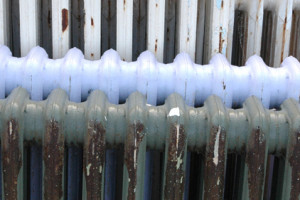This all-technical, three-hour seminar will make you familiar with the many types of old steam heating systems and what goes wrong with them. Dan Holohan’s easy-to-follow...
Steam piping gone wrong

A steam stumper!
In Baltimore, about four blocks from my house, there lives an elderly couple. They're still in the same three-bedroom cottage where they raised their family. This house is one of several built from the same plans during the 1920's. All of these houses have one-pipe-steam heating systems, with a single two-inch main that's about 50 feet long and wraps around the basement.
At some point, they added a large family room built onto the back of this house. To heat the family room, they tied radiators into the existing steam system. One of these was a 105-square foot monster with its own return line to make sure the condensate got back to the boiler properly. They also installed a larger boiler to handle the increased load, but the system never worked properly after that. It would bang and hiss. Some rooms were cold and the water level in the boiler was extremely unstable. And the oil bills were way too high.
When I first got there, I found that the near-boiler piping wasn't quite right. There was no main vent, the pressuretrol was cranked up to 5 psi and the water feeder was mounted on the Hartford Loop! So I got to work. I moved the feeder to its rightful place on the boiler and installed a big main vent (a Gorton #2), and I cranked down the pressuretrol. That slightly tamed the water level and got the steam to the radiators at the end of the main. But the system still hissed and banged, and the water in the boiler was still very unsteady. So I checked the boiler's capacity against the radiation, thinking that it might be oversized. The system had 409 square feet EDR and the boiler was rated at 556 square feet EDR, but it had been downfired. I was pretty sure this wasn't the problem.
The owners were going away for the holiday season that year. They were concerned that something might go wrong with the boiler during that time. I told them if they would leave me a key, I'd keep an eye on it. After all, that's what neighbors are for. They were very happy for me to do so.
One weekend, I decided to take another look at the system. I turned up the thermostat and sat in the basement, listening to the system. I followed the steam around the main and noted when it reached the various radiator runouts. Everything seemed fine until I got to a runout that I couldn't account for. It ran to a place where there wasn't a radiator. But there was steam going into it. A few minutes later the system started to complain. It hissed and banged, and the water in the boiler started bouncing.
I went upstairs and discovered that all the radiator vents were hissing loudly. All except one, that is. The monster radiator in the family room was quiet. There was some heat coming off of it, but the vent was closed. Then it hit me. I felt the return elbow coming off the radiator. It was steam-hot. I pulled the couch away from the front of the radiator and felt over the entire radiator. It was hot across the very top, and in the end section where the vent was. The rest of the radiator was stone cold.
Whoever had installed that radiator had run the return line back into the steam main, with no way to keep the steam from going up the return line and closing the radiator vent! And since the radiator was rated 105 square feet, it was about 25% of the total system load. When the vent on that radiator closed, the boiler suddenly became way oversized, causing the banging & hissing.
So I got some pipe and fittings and rerouted the radiator return into the wet return main near the boiler. I piped it well below the waterline in the classic two-pipe, air-vent arrangement. Then I put the biggest vent I could find on that big radiator. I chose a Gorton #D.
When I started the system, it was eerily quiet. The monster family room radiator started pounding out heat as never before. It filled with steam at the same time as all the other radiators, which have Hoffman #40 vents and range from 20 to 50 square feet. The water level in the boiler was bouncing just a bit, but no more than usual for that type of boiler. And the system didn't bang or hiss once. The owners had a very pleasant surprise when they got home.
One of these days, we'll get around to redoing that near-boiler piping.
(You'll find Steamhead HERE.)
Leave a comment
Related Posts

In this all-technical three-hour seminar, Dan Holohan will give you a Liberal Arts education in those Classic Hydronics systems. He’ll have you seeing inside the pipes as...

So I’m visiting a wholesaler in an old town on Long Island where my Uncle Tony worked when he was still on this side of the lawn. You would have liked him. A homeowner wa...